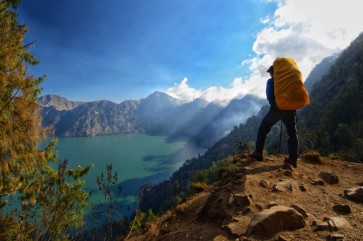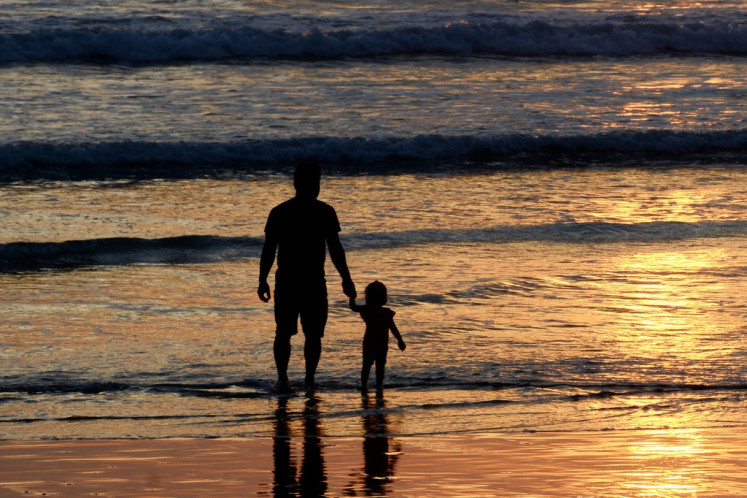Popular Reads
Top Results
Can't find what you're looking for?
View all search resultsPopular Reads
Top Results
Can't find what you're looking for?
View all search resultsA Pandora’s box with ample hope to offer
Ancestral: Pinogu offers beautiful vistas, and is believed to be the home of the people of Gorontalo
Change text size
Gift Premium Articles
to Anyone
Ancestral: Pinogu offers beautiful vistas, and is believed to be the home of the people of Gorontalo.
Pinogumbala is an old village within a forested area in the easternmost part of Bone Bolango regency in Gorontalo.
The name of the village means “battlefield”, chosen as a reminder of the battle between two royal brothers, Pulumuduyon and Mooduto.
Daitom Wantogia and Yusuf Wantogia, the authors of The History of Gorontalo: The origins of Suwawa, Limboto and Gorontalo, published in 1980, estimate that the event took place in 1427. Now, the remote area better known as Pinogu is virtually an enclave within the forest zone of Bogani Nani Wartabone National Park (TNBNW).
Pinogu is a fertile village believed to be the former site of Leda-Leda, an ancient monarchy and the embryo of the other kingdoms in Gorontalo. Pinogu is also considered the land of the Tiyombu, the forebears of the people of Gorontalo.
Isolated: A young boy stands in a road in Pinogu, a hard-to-reach village in Gorontalo and a 30-kilometer walk or 46-kilometer motorcycle ride from the closest village of Tulabolo.The shorter route to Pinogu spans 30 kilometers from Tulabolo, the last village next to the enclave and 45 minutes’ drive from the capital city of Gorontalo.
Travelers can walk to Pinogu along the 30-kilometer path through Gorontalo’s tropical forest and conservation area, which serves as its largest ecosystem buffer zone. The terrain is rough and teeming with leeches in the rainy season. People from Pinogu usually take 6 to 7 hours to reach their village by this “shortcut”, crossing several tributaries and traveling by boat along the Bone River, the main water supplier of Gorontalo.
Visitors take longer, usually 12 to 15 hours, as the walk requires much rest from the long walk.
The longer route, 46 kilometers from Tulabolo, is passable by motorcycle taxi, which takes 7 to 9 hours depending on the weather. Along both routes tourists can enjoy the beauty of the forest and hear the cries of Sulawesi macaques and the hooting of hornbills.
TNBNW is known for its high and endemic biodiversity. Lying at an altitude of 300 meters and covering 360 square kilometers with 2,044 residents, Pinogu obtained pre-district status in April 2012. Five times as large as the city of Gorontalo, Pinogu consists of five hamlets: Bangio, Pinogu, Dataran Hijau, Pinogu Permai and Tilonggibila.
The fertile soil of Pinogu makes it abound with agricultural produce and secondary crops, with local farmers generally practicing hulunga or mutual assistance in crop planting. Visitors can also savor organic rice out of paddy grown without chemical fertilizers.
The area has long been famous for its resilient food supply. However, this promising village still offers little hope for further progress for its residents. Pinoguans can’t do much with their abundant produce for the lack of market access as a result of extremely poor transportation facilities and thus the very high cost of commodity delivery.
Gandi M. Hadju, 62, a Pinogu community figure, said that in 2001 most farmers were forced to burn heaps of local corn because it had piled up in granaries for six months and had been eaten by worms. “Nobody was willing to consume [it] for free, not even chickens, so we had to destroy [it],” he recalled.
In Pinogu, the cost to transport goods by manpower and motorcycle taxi is high, ranging from Rp 5,000 (53 US cents) to Rp 6,000 per kilogram.
Ismet Nadjamuddin, head of Tilonggibila hamlet in Pinogu, said most Pinogu people desired proper road access. “We’re sure the village economy will improve with the support of good transportation,” he said.
According to Iwan Mustapa, the head of Bone Bolango’s Regional Development and Planning Agency (Bappeda), road construction in Pinogu was in fact already attempted in 2001 in the form of road hardening.
Even before the road was half-finished, legal action was taken against the project, which was seen as illegal for damaging TNBNW’s conservation area and a project contractor was sentenced to two years in jail.
With the growing demand on the part of the local community, in 2004 a principle license for road building was filed, with the official signing by relevant parties in mid-2012, Iwan said.
The road development, to be handled by the Indonesian military, is slated for September 2012. “In the initial phase the road will be built with 2x2-meter concrete blocks along six kilometers, complete with guard posts and gates,” he said. The size of the road is such as to be only passable by motorcycles to prevent illegal logging within the park. The Pinogu-Tulabolo road project is projected to take five years at a total cost of almost Rp 4 billion.
In early July, Bone Bolango’s Bappeda initiated a Pinogu Expedition followed by teams from different backgrounds and scientific disciplines, journalists, students, nature lovers, the National Mapping and Survey Coordinating Agency (Bakosurtanal) and the Indonesian Institute of Sciences (LIPI).
The expedition was meant to introduce Pinogu’s potential to the general public. Sudarmono, a LIPI team member, said he had found in the village various unique plants including rafflesia, considered typical of Sulawesi. “I think a lot of rare species of vegetation belong to TNBNW’s collection, with Pinogu inside the park, which should all be protected,” he said.
Alim Niode, a cultural observer and sociologist from Gorontalo State University who joined the expedition, noted that so far many people believed that Pinogu was the origin site of the people of Gorontalo and was purposely hidden so that the story of Pinogu remained partly a mystery.
“This is an ancestral message that should be treated with care in the opening of road access, with all its risks and solutions requiring proper response and preparations at an early stage,” he said.
As a village with bountiful natural resources including gold mines, Pinogu is quite vulnerable to social and ecological shocks with their far-reaching impact. After the road access is completed, according to Alim, the task ahead is to guarantee the sustainability of those resources and further develop Pinogu’s potential socially, culturally and economically.
The upper reaches of the Bone River constitute the largest water reserve in Gorontalo, supplying the region’s agriculture and water consumption needs.
Any damage inflicted on the national park by illegal logging or mining will impact the life of not only the people of Pinogu with their crucial role in maintaining the ecosystem, but also the life of the Gorontalo population.
Pinogu, the land of the Tiyombu or ancestors, is treated as a sort of Pandora’s box with the fear of imminent calamity. But, there remains ample hope.
“The natural resources of the zone remain the greatest hope for the livelihood of Gorontalo society, which should be well conserved in order to avoid various catastrophes,” Alim said.
— Photos by Syam Terrajana











